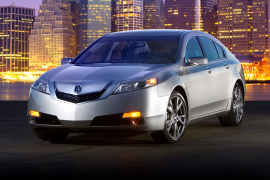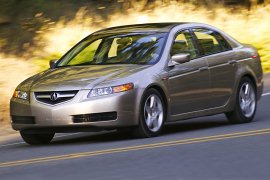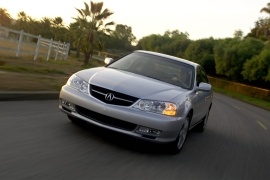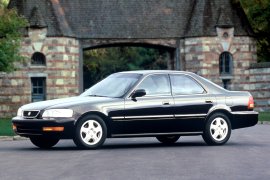ACURA TL Models/Series Timeline, Specifications & Photos
First production year: 1995
Engines: Gasoline
Honda's luxury division Acura introduced in late 2008 a new generation for the TL model. It was based on the European Honda Accord but had many more things to say.
The main characteristic of any Acura TL was its sportiness. It was the sporty-sedan that gave more than decent performances, enough luxury amenities, and all packed for a good price. The design though had some flaws.
The massive front shield-grille on the 2008 Acura TL was clearly a love-it-or-hate-it part of the car. The Acura marketing department named that grille as "Power plenum", also nicknamed "Gladiator shield". Except that the Gladiator movie was a hit 8 years before the TL was launched so no one remembered it. The rear of the car had the same angled panels that resembled the "Gladiator shield". Maybe the biggest problem was that it was chromed.
Inside the 2008 Acura TL, there was he same European, 8th generation Accord. An unusual feature of that luxury sporty sedan was the manual transmission. Unlike the European sibling that had only 4-pot engines, the TL featured two V6 engines. Both could have been mated to a 6-speed manual or to a 5-speed automatic. The top version, with a 3.7-liter engine, was offered as all-wheel-drive with the SH-AWD system which was more like a system with active differentials. A step forward in the all-wheel-drive technology, used mostly in rally-racing.
The 2004 model of Acura TL was a real game-changer for the Japanese car manufacturer. The high quality and sporty chassis captured the attention immediately.
Compared to the previous generation of the TL, the 2004 model was better in every detail. The aggressive look was matched with an optional sport suspension and Brembo brakes. Since it was known as a sporty brand with good performance for its class, it was offered as standard with a 6-speed manual.
Inside, the car was well equipped and had a Bluetooth connectivity for the audio system. An 8” touch-screen LCD infotainment system developed by Alpine was available as an option and had voice commands. But even on the base audio system, it featured the hands-free connectivity with the mobile phone. It was the first car to be sold in the U.S. with a 6-DVD changer on board, but it couldn't read MP3 files. The instrument cluster was simple, with a large speedometer and tachometer plus the fuel level and coolant temperature. An on-board computer display was shown on a small screen.
There was only one engine available, but it was powerful enough for the light vehicle. It had under 3500 lbs (1500 kg), with manual transmission. A 5-speed automatic transmission was available as an option that also offered the possibility to manually change the gears.
The second generation of the Acura TL was built in the U.S., unlike its predecessor that was built in Japan. It was the model that Honda pushed hard into the premium segment market.
The 1999 Acura showed-up on the market with features that were mind-bending for that year. It wasn't only the navigation system, but that unit featured a touch-screen, which was unique on the market. It was well equipped and offered good performance for those times.
The designer took their inspiration from an off-shore speed-boat, and that's how the grille took shape. The aggressive style of the car, with raked grille and A-pillars, formed a balanced shape for the TL. Dual exhaust was installed in the back, to enhance the sporting appeal.
The interior featured new materials for the brand. Special leather upholstery was used for most of the cabin. Some interior trims mimicked wood. The center console offered two cup-holders with a dual-split lid. The instrument cluster was typical for any Honda or Acura, with four round dials. On the center stack, on the upper trim levels, the Acura TL featured a touch-screen navigation system. In 2000, the car-maker replaced the CD-based system with a DVD based one. With the new version, it was possible to cross guided the U.S. from coast to coast.
For the platform, the Acura TL featured a double-wishbone front suspension, which was much better on road-handling than the McPherson struts used by most of its competitors. There was only one transmission offered, a 4-speed automatic with sequential manual shifting. It was replaced in 2000 by a similar 5-speed unit.
In 1996, Honda decided to change the naming system for the Acura brand, and the first model that received the new alphanumeric designation system was the TL.
Acura TL came on the market to replace the previous Acura Vigor, and it aimed at the Infiniti i30 and the Lexus ES, but with a sport-oriented platform. Nevertheless, it was nothing short in features and amenities like its main competitors. Still, it didn't offer the same luxury feeling and image as those two.
The design language was carried over from the larger model Legend but in a shorter package. Its front fascia featured horizontal headlights with corner-mounted parking lights and blinkers. At the same time, the turn signals were doubled on the lower side of the bumper. Its narrow grille was encircled by a chromed trim, trying to create an upscale image for the car. Unusually for this car segment, the TL featured frameless windows.
Inside, the TL was larger than the Vigor it replaced but still didn't offer enough room for three adults on the rear seats. The wood trims matched the classy Acura instrument cluster, but some of the materials used didn't match those offered by Lexus in the ES 300. And yet, thanks to the sportier, bolstered seats, younger customers were attracted more by this TL.
The TL featured a longitudinally-mounted engine layout like the Legend, leading to a shorter front overhang and a better weight distribution. The base version featured a 2.5-liter inline-five, marketed as the sportier version, while the 3.2-liter V6 was promoted as a more luxurious vehicle. Unfortunately, both lacked the sporty feel due to the four-speed automatic gearbox, which was the only transmission available.



